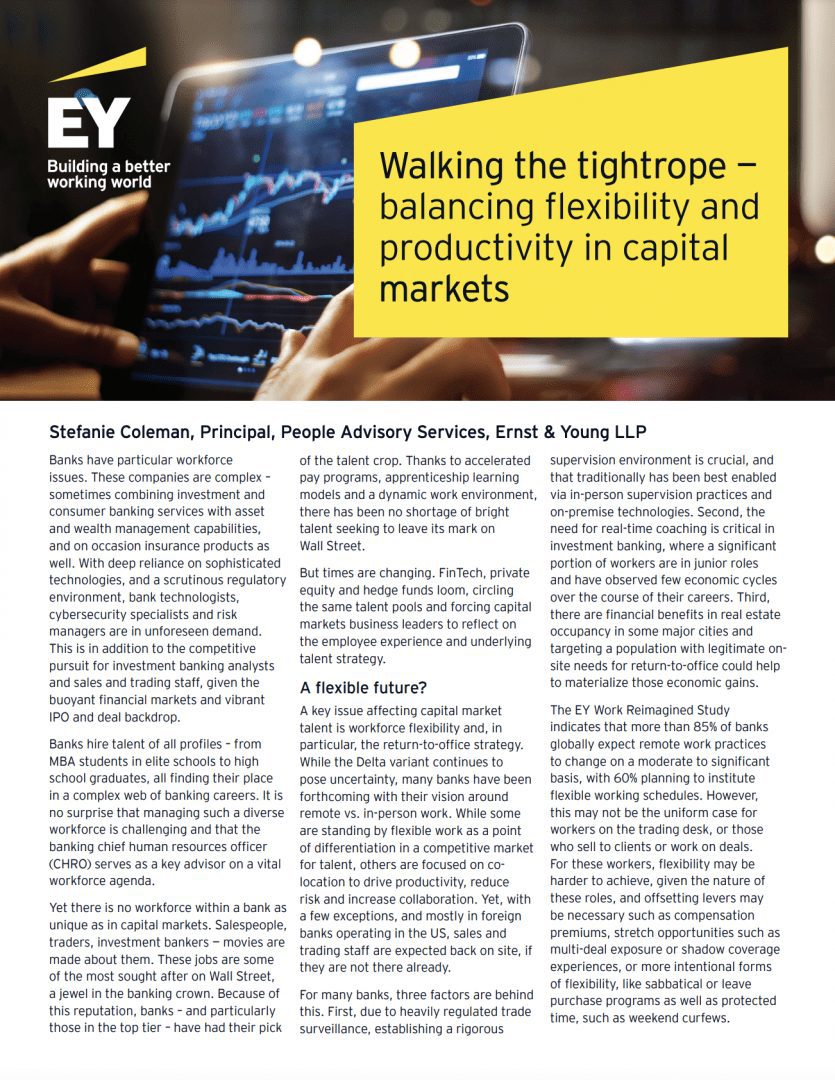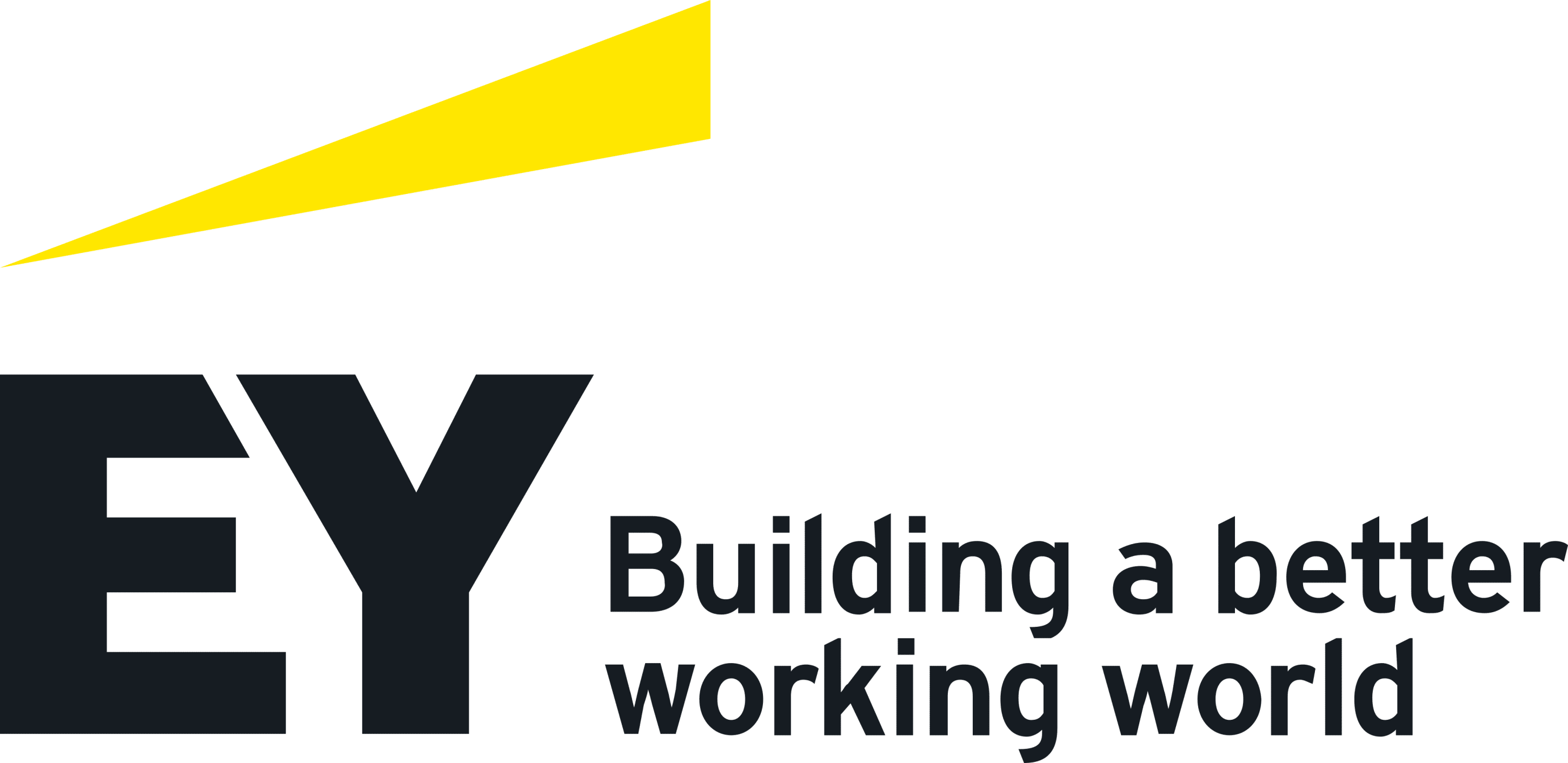by Stefanie Coleman, Principal, People Advisory Services, Ernst & Young LLP
Banks have particular workforce issues. These companies are complex – sometimes combining investment and consumer banking services with asset and wealth management capabilities, and on occasion insurance products as well. With deep reliance on sophisticated technologies, and a scrutinous regulatory environment, bank technologists, cybersecurity specialists and risk managers are in unforeseen demand.This is in addition to the competitive pursuit for investment banking analysts and sales and trading staff, given the buoyant financial markets and vibrant IPO and deal backdrop.
Banks hire talent of all profiles – from MBA students in elite schools to high school graduates, all finding their place in a complex web of banking careers. It is no surprise that managing such a diverse workforce is challenging and that the banking chief human resources officer (CHRO) serves as a key advisor on a vital workforce agenda.
Yet there is no workforce within a bank as unique as in capital markets. Salespeople, traders, investment bankers — movies are made about them. These jobs are some of the most sought after on Wall Street, a jewel in the banking crown. Because of this reputation, banks – and particularly those in the top tier – have had their pick of the talent crop. Thanks to accelerated pay programs, apprenticeship learning models and a dynamic work environment, there has been no shortage of bright talent seeking to leave its mark on Wall Street.
But times are changing. FinTech, private equity and hedge funds loom, circling the same talent pools and forcing capital markets business leaders to reflect on the employee experience and underlying talent strategy.
A flexible future?
A key issue affecting capital market talent is workforce flexibility and, in particular, the return-to-office strategy. While the Delta variant continues to pose uncertainty, many banks have been forthcoming with their vision around remote vs. in-person work. While some are standing by flexible work as a point of differentiation in a competitive market for talent, others are focused on colocation to drive productivity, reduce risk and increase collaboration. Yet, with a few exceptions, and mostly in foreign banks operating in the US, sales and trading staff are expected back on site, if they are not there already.
For many banks, three factors are behind this. First, due to heavily regulated trade surveillance, establishing a rigorous supervision environment is crucial, and that traditionally has been best enabled via in-person supervision practices and on-premise technologies. Second, the need for real-time coaching is critical in investment banking, where a significant portion of workers are in junior roles and have observed few economic cycles over the course of their careers. Third, there are financial benefits in real estate occupancy in some major cities and targeting a population with legitimate onsite needs for return-to-office could help to materialize those economic gains.
The EY Work Reimagined Study indicates that more than 85% of banks globally expect remote work practices to change on a moderate to significant basis, with 60% planning to institute flexible working schedules. However, this may not be the uniform case for workers on the trading desk, or those who sell to clients or work on deals.
For these workers, flexibility may be harder to achieve, given the nature of these roles, and offsetting levers may be necessary such as compensation premiums, stretch opportunities such as multi-deal exposure or shadow coverage experiences, or more intentional forms of flexibility, like sabbatical or leave purchase programs as well as protected time, such as weekend curfews.
Productivity and workforce life balance
Achieving a balance between work and personal life is a common challenge in the capital markets culture. In a fast-paced trading environment, or when closing a high-profile deal, the demands of these jobs are high. This does not go unnoticed by business leaders, and several investment banks have put in place spot bonuses to compensate analysts for long working hours, as well as other health and lifestyle policies, such as office curfews and exercise equipment benefits, to support well-being.
The digital transformation agenda under way in many banks is helpful to this discussion. As shown in the EY Work Reimagined Study, the pandemic has accelerated some of these efforts, where 65% of participating banks globally are enhancing their technologies to support virtual project planning, communications, dashboarding, and idea sharing. As several banks seek to innovate investment banking operations via technology, a significant portion of time-consuming work traditionally delegated to junior levels can be automated using bots. This includes modeling, prospectus creation, environmental, social and governance (ESG) and investor screening, and platform integrations that enhance real-time analytics. In doing so, banks have an opportunity to redesign investment banking roles so they are focused on higher-value and less time-intensive activities, like generating ideas and building client relationships. Once roles are redefined to take into account automation impacts, capital markets leaders should be well-positioned to recast capacity plans so that the demand for talent can be matched with a reasonable supply through a thoughtful strategy of hiring, upskilling and outsourcing.
Purpose-driven work
Diversity equity and inclusion remain a top priority for banking executives along with the increasingly prominent ESG agenda across the sector. To support this focus, some targeted programs have been put in place within capital markets businesses, such as sponsorship programs intended to grow the pipeline of women and racially and ethnically diverse bankers. Additionally, at least one bank is funding the secondments of top-performing bankers and traders to black-owned banks in the US in order to drive product development and innovation activities within these smaller firms. Within the technology domain, some banks have examined the educational requirements needed to successfully perform in certain trading technology support roles, which has improved hiring activity by expanding the candidate pool to a much broader network of candidates. Finally, some banks are intentionally diversifying coverage teams in order to match the diversity profile of their clients, which is increasingly a baseline requirement.
The draw for talent in the capital markets is competitive, with several firms experimenting with new levers to attract and retain the best employees. In an environment where there is growing demand for labor in a limited force of tired and isolated workers, it has never been more important to lead with people at the center. So why wait? Put people first today and reap the rewards tomorrow.
Andy Sears, Managing Director, EY Financial Services Business Consulting, also contributed to this article. The views expressed by the authors are not necessarily thoseof Ernst & Young LLP or other members of the global EY organization.


Stefanie Coleman
Principal, People Advisory Services, Ernst & Young LLP
EY exists to build a better working world, helping to create long-term value for clients, people and society and build trust in the capital markets.
Enabled by data and technology, diverse EY teams in over 150 countries provide trust through assurance and help clients grow, transform and operate.
Working across assurance, consulting, law, strategy, tax and transactions, EY teams ask better questions to find new answers for the complex issues facing our world today.
EY refers to the global organization, and may refer to one or more, of the member firms of Ernst & Young Global Limited, each of which is a separate legal entity. Ernst & Young Global Limited, a UK company limited by guarantee, does not provide services to clients. Information about how
EY collects and uses personal data and a description of the rights individuals have under data protection legislation are available via ey.com/privacy. EY member firms do not practice law where prohibited by local laws. For more information about our organization, please visit ey.com.
© 2021 Ernst & Young, LLP.
All Rights Reserved.
2109-3887648
ED None
This material has been prepared for general informational purposes only and is not intended to be relied upon as accounting, tax, legal or other professional advice. Please refer to your advisors for specific advice.
